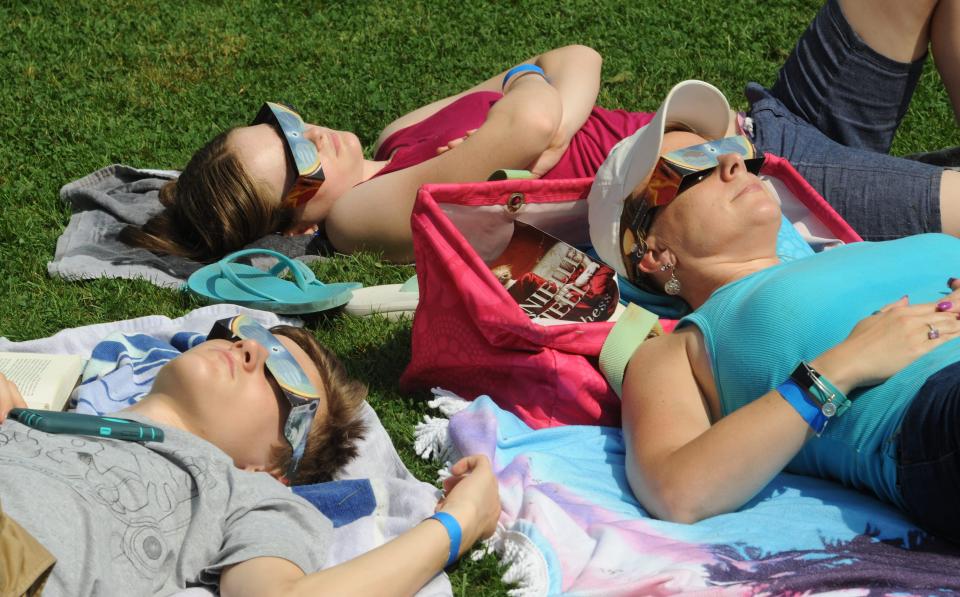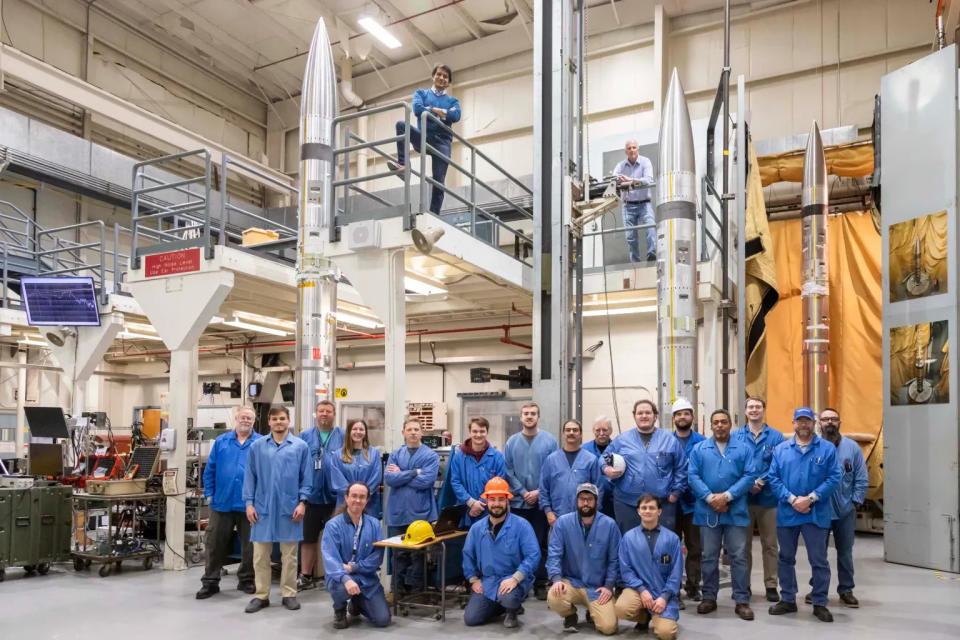Monday's the day: Here's your total solar eclipse weather forecast
Monday is the day serious eclipse fans have been waiting years for.
Monday afternoon, weather permitting, a total eclipse of the sun will grace the skies above the U.S., all the way from southern Texas to northern Maine.
It will be the last total solar eclipse visible from the lower 48 states until 2044.
Tens of millions of people in the United States are expected to see the eclipse, and even those who find themselves outside its direct path are likely to witness the stunning celestial event in some form.
Here's the latest weather forecast:

Where will the solar eclipse be visible? A 'nearly perfect day' for some
Federal forecasters said the best chances for clear skies within the path of totality will be in northern New England, despite some chilly temperatures: "New England will likely wake up to clearing skies with cold temperatures into the 20s Monday morning under a fresh snow cover from the recent nor'easter," National Weather Service forecaster Kwan-Yin Kong said Sunday.
The weather service forecast office in Caribou, Maine, confirmed that Sunday. "Despite being in a relatively active stormy period, somehow we scored a nearly perfect day Monday to observe the eclipse under sunny to mostly sunny skies during the mid-afternoon hours," the service said in a forecast discussion.
In Burlington, Vermont, weather service forecasters also were optimistic, despite the chance of some high clouds streaming in during the afternoon: "Cloud cover should not be thick enough to obscure the event," forecasters said.
Get ready: The total solar eclipse is Monday: Here's everything to know, including time, path, safety
Meteorologists at Weather.com were also enthused about the splendid forecast for the region: "The portion of the path of totality in northern New England could have some of the best weather in the country for viewing," meteorologist Jonathan Erdman said.
There probably will be breaks in the clouds from northern Arkansas to central Ohio behind a front. But that is the area of "greatest uncertainty due to potential high clouds," the Weather Prediction Center said.
[4/7/2024]
Updated Key Messages for tomorrow's total solar eclipse and cloud cover forecast are available. High clouds spanning across parts of the totality path are likely, but may not completely obscure the eclipse. For local forecasts visit https://t.co/pGx1JRZLBI. pic.twitter.com/d4JgEXorsF— NWS Weather Prediction Center (@NWSWPC) April 7, 2024
Outside the path of totality, which stretches from Texas to Maine, AccuWeather meteorologist Brandon Buckingham said, "the best locations for viewing can be the Southwest deserts, much of California, New England and parts of the Southeast."
He said major cities such as Los Angeles, El Paso, New York, Boston and Raleigh, North Carolina, should all have nice views of the eclipse from start to finish.
Where will it be cloudy?
Unfortunately for folks in the path of totality, adverse viewing conditions are expected from Missouri and Kansas southward into central and east Texas, AccuWeather said, where it is likely to be cloudy with showers and perhaps some thunderstorms.
Kong said southern Texas will wake up to considerable clouds Monday morning.
The Weather Prediction Center said Sunday afternoon that clouds may also impede viewing across Ohio, northwest Pennsylvania and parts of New York. Rain showers are possible during totality in all of those areas.
For the partial eclipse, AccuWeather long-range expert Joe Lundberg added that "other areas with poor viewing conditions will be from Wisconsin westward through South Dakota and Nebraska to Washington and Oregon."
Severe storms, tornadoes possible in South
Severe thunderstorms were expected to rattle portions of the southern U.S. on Monday and Tuesday.
"Multiple rounds of severe thunderstorms should develop from early afternoon Monday through Tuesday morning across a large portion of Texas, into south Oklahoma, southwest Arkansas, and west Louisiana," the Storm Prediction Center said Sunday. "A few tornadoes, scattered large to very large hail, and isolated severe wind gusts will be possible."
Big Texas cities such as Dallas, Houston, San Antonio and Austin are all at risk of severe storms Monday, the center said.
Heavy rainfall could lead to flash flooding across the region, the Weather Prediction Center warned.
12:59am CDT #SPC Day2 Outlook Slight Risk: in the southern Great Plains https://t.co/Y1WiOd8TQQ pic.twitter.com/pe8w2eWnJw
— NWS Storm Prediction Center (@NWSSPC) April 7, 2024
What time is the solar eclipse?
The eclipse will begin in Texas at 1:27 p.m. CDT and end in Maine at 3:35 p.m. EDT, but the exact time of the eclipse varies by where you are in its path. You can search by ZIP code to find the exact time for your location.
Can you drive during a solar eclipse?
It's safe to drive during an eclipse as long as you don't look up at the sky. AAA is telling drivers to be focused on the road during the total solar eclipse.
The automobile insurance company is advising Americans who want to safely view the eclipse to find a safe place to park and wear your eclipse glasses.
Authorities also are reminding people to not drive while wearing solar eclipse glasses. Eclipse glasses are designed specifically for an eclipse, and you would not be able to see the road well enough while wearing them.
Canada will get to see the show, too
The eclipse also will grace the skies above five eastern provinces of Canada. It's the first of its kind since 1979 in Canada, and it is creating a carnival atmosphere there. Many people have been making travel plans for months.
In the Niagara Falls area, the local government has declared a state of emergency. More than 1 million people, a record, are expected to converge along the majestic falls and the popular tourist destination.
Your dogs and cats will be fine
Don't worry, your dog or cat probably will be oblivious to the eclipse, according to Pasco, a science education company.
"It is unlikely that dogs and cats will react to solar eclipses, as they typically do not have a strong biological or behavioral response to changes in light or natural phenomena like eclipses," Pasco reports.
Just in case, Pasco recommends you keep your pets inside during the eclipse and distract them with toys or treats.
How to photograph a solar eclipse with your cellphone
You'll need to have the right solar filter in front of your cellphone camera to protect both your device and eyesight, according to Carly Stocks, a Utah-based astronomical photographer who talked to USA TODAY.
The filter must be made specifically for solar viewing, Stocks said. She also emphasized the need to place a filter that is larger than the lens itself and to keep it on at all times if you're in a location where the eclipse is only partially visible. She recommends purchasing a small 4- by 4-inch sheet of the Thousand Oaks solar filter.
And if you're observing the sky in a location where the total eclipse is visible, you'll have a moment when you can take off the solar lens entirely and capture unfiltered images.
"During totality, you can remove all filters," Stocks told USA TODAY. "If you're looking with the solar glasses and you don't see anything, then it's safe to look at it during that time."
When is the next total solar eclipse visible from the U.S.?
It will be 20 years before there's a chance to witness a total solar eclipse in the United States again.
According to NASA, after the total solar eclipse on April 8, the next total solar eclipse that can be seen from the contiguous U.S. will be on Aug. 23, 2044.

NASA will launch 3 rockets into space during the eclipse
NASA is preparing to launch three giant rockets into our atmosphere on the day of the eclipse. The agency is hoping to gather some valuable scientific data about how solar eclipses alter Earth’s upper atmosphere.
NASA is using spacecraft called sounding rockets that are equipped with scientific instruments to take measurements and perform experiments during its sub-orbital flight.
The three rockets will launch from NASA’s Wallops Flight Facility in Virginia and will reach an intended altitude of 260 miles, NASA said. That's high enough to study disturbances during a total solar eclipse in the ionosphere, a region of Earth’s atmosphere between 55 to 310 miles above the ground.
Scientists hope to collect data on how the sun's sudden disappearance during the eclipse creates disturbances that could interfere with communications here on Earth.
“Understanding the ionosphere and developing models to help us predict disturbances is crucial to making sure our increasingly communication-dependent world operates smoothly," said mission leader Aroh Barjatya, an engineering physicist at Florida's Embry-Riddle Aeronautical University.
Contributing: Reuters; Dan D’Ambrosio, the Burlington Free Press; Eric Lagatta, USA TODAY
This article originally appeared on USA TODAY: Solar eclipse 2024: Where will the weather be best for viewing?

